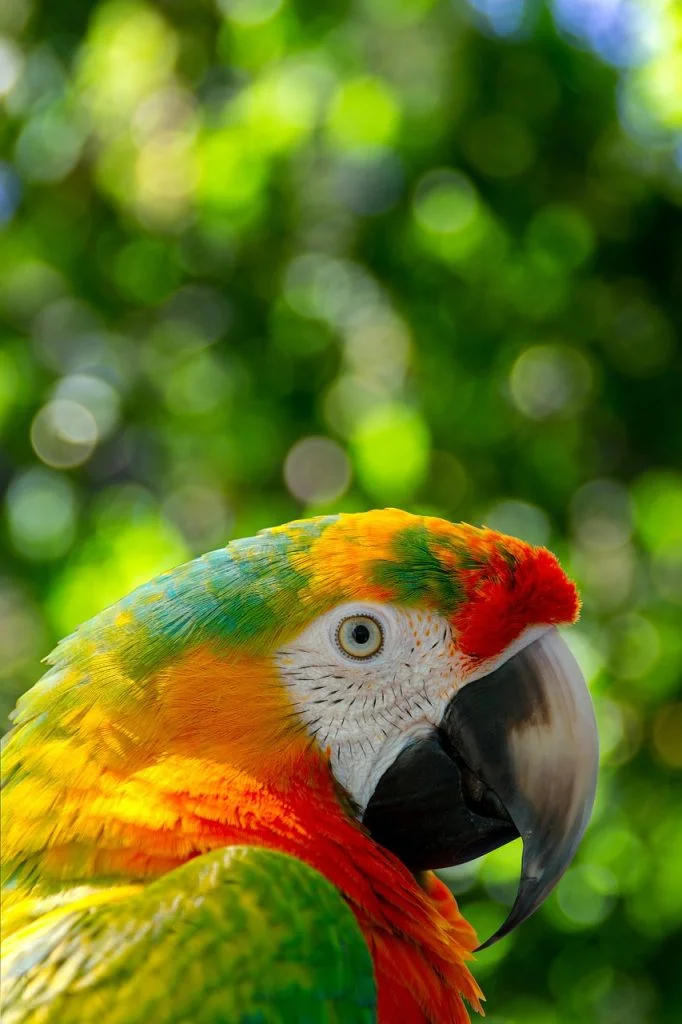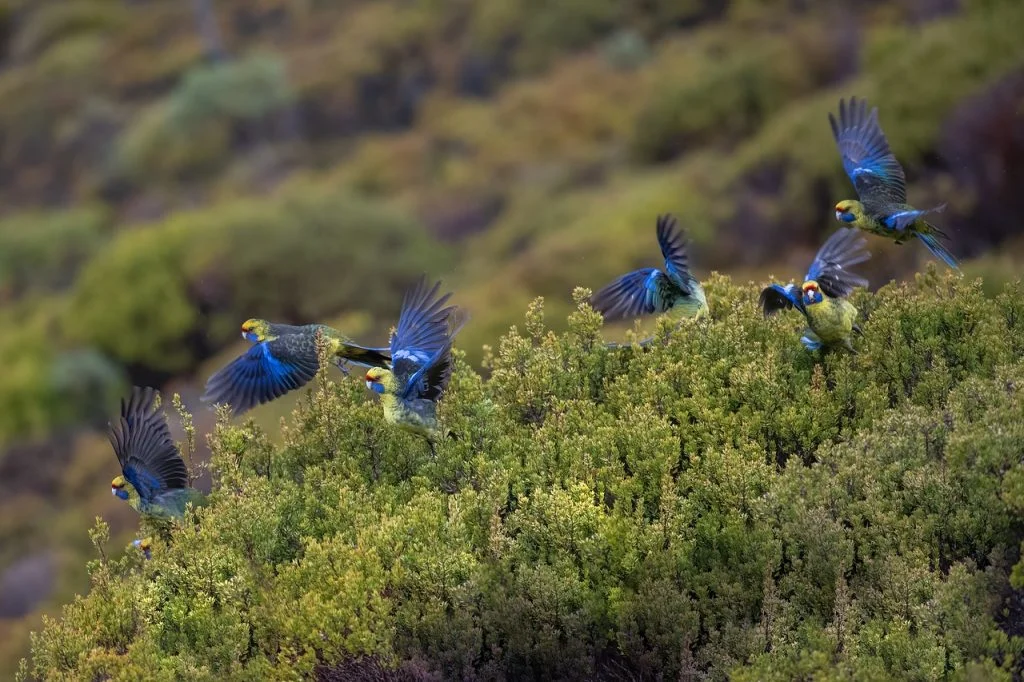Welcome to the epic world of parrots, where feathers are brighter than a neon sign in Vegas and squawks can rival any teenager’s music volume.
Did you know that these feathered comedians are not just about looks and noise? They’re smart too, often outwitting their human companions in a game of ‘hide the seeds‘. Ever wondered why parrots can mimic human speech? It’s because they have a brain-to-body size ratio similar to that of higher primates and dolphins.
But here’s a question for you: have you ever tried having a conversation with a parrot, and if so, who won the debate?
The more I learn about people, the more I love my parrot.
Mark Twain
Parrot Facts
Get ready to soar into the colorful world of parrots! Don’t forget, there’s a quiz at the end of this journey, so keep your eyes open for every feathered fact.
- Parrots belong to the order Psittaciformes, which includes over 350 bird species.
- These birds are known for their highly intelligent and social nature.
- Some parrot species can live for more than 60 years.
- The Kea, a New Zealand parrot, is known for its curiosity and playfulness.
- Parrots have zygodactyl feet (two toes facing forward and two backwards), aiding in climbing.
- Their beaks are strong and curved, making them ideal for cracking nuts and seeds.
- Parrots are one of the few bird species able to imitate human speech.
- Their vivid colors come from a combination of pigments and light refraction in their feathers.
- African Grey Parrots are renowned for their exceptional cognitive abilities.
- Parrots engage in social grooming, also known as ‘allopreening’.
- The world’s smallest parrot is the Buff-faced Pygmy Parrot, only about 8 cm long.
- Parrots have a specialized tongue to help them consume fruit, seeds, nectar, and pollen.
- Lorikeets have brush-tipped tongues for feeding on nectar.

- Most parrots are monogamous and form lifelong bonds with their partners.
- The Hyacinth Macaw, the largest parrot, can be up to 1 meter in length.
- Parrots exhibit geophagy, consuming clay to detoxify their diet.
- Parrots are found on all tropical and subtropical continents.
- The Kakapo, a flightless parrot, is critically endangered and native to New Zealand.
- Parrots have a four-chambered heart, similar to humans.
- Some parrots, like the African Grey, have a distinctive red tail.
- Parrots can rotate their heads up to 180 degrees.
- Their binocular vision gives them excellent depth perception.
- A group of parrots is known as a ‘pandemonium’.
- Parrots can learn to use tools, showing advanced problem-solving skills.
- The majority of parrots are tropical birds.
- Nestor notabilis, or the Kea, is known for its intelligence and curiosity.
- Parrots’ vocalizations can include songs, squawks, and mimicked sounds.
- Alex, a famous African Grey, was studied for 30 years for his cognitive abilities.

- Some parrot species are nocturnal, like the Kakapo.
- Their beak growth is continuous, requiring regular wear down.
- Macaws use their tail feathers for balance.
- Parrotfish, named for their beak-like mouths, are not related to parrots.
- Parrots have strong social hierarchies within their groups.
- Their feet are adept at grasping and manipulating objects.
- Wild parrots often mimic sounds from their environment, not just human speech.
- Most parrot species are diurnal, active during the day.
- Cockatoos have a distinctive crest of feathers on their heads.
- Parrots can suffer from loneliness and depression if isolated.

- Eclectus Parrots show extreme sexual dimorphism, with males and females looking very different.
- Their color vision is more advanced than humans, extending into the ultraviolet.
- Amazon parrots are known for their robust build and short tails.
- Their ability to mimic sounds is a form of social learning.
- Some parrot species are endangered due to habitat loss and pet trade.
- Parrots can express emotions through body language and vocalizations.
- Psittacosis, or ‘parrot fever’, is a rare disease transmitted from birds to humans.
- They have a highly developed cerebrum, akin to that of higher mammals.
- Parrots can engage in playful behaviors, including playing with toys.
- Many parrots have the ability to dance to music.
- Conservation efforts are crucial for protecting endangered species like the Spix’s Macaw.
- Finally, parrots play an important role in their ecosystems as seed dispersers and pollinators.
Parrot Myths

After reading a good amount of interesting facts about parrots, now it’s time to uncover some popular myths. Let’s see the actual truth behind them.
- Parrots are Easy Pets for Everyone
Parrots are actually quite challenging pets. They require a lot of attention, social interaction, and mental stimulation. Many parrots can live for decades, so it’s a long-term commitment. They’re not just pretty birds to look at; they’re more like feathery friends who need your time and love. - Parrots Can Live on Seeds Alone
This is a big no-no! Just like us, parrots need a varied diet. Seeds alone won’t cut it. They need fresh fruits, vegetables, and specially formulated pellets. It’s like saying we could live on popcorn alone – tasty, but not enough! - Parrots Will Learn to Talk Naturally
Not all parrots will talk, and it’s not a given. It’s like expecting every child to be a singing prodigy. Some parrots are chatty, others prefer to whistle or stay quiet. Talking requires patience, training, and a lot of interaction. - Parrots Don’t Need Veterinary Care
Just like cats and dogs, parrots need regular check-ups. They can hide illnesses well, so regular vet visits are crucial. - Parrots are Fine Living Alone
Parrots are social creatures. They thrive on interaction, either with humans or other birds. A lonely parrot can become depressed or develop behavioral problems.
No products found.
Parrot Quotes

Whether you’re an experienced parrot enthusiast or a curious onlooker, I am sure you are going to love my list of favorite quotes about them. Feel free to share more in the comments so I can add them here.
A parrot talks much but flies little.
Wilbur Wright
Wilbur Wright uses the metaphor of a parrot to emphasize the importance of action over mere words.
God loved the birds and invented trees. Man loved the birds and invented cages.
Jacques Deval
Jacques Deval reflects on the contrast between the natural world and human intervention, particularly in the context of birds like parrots.
In order to see birds it is necessary to become a part of the silence.
Robert Lynd
Robert Lynd expresses the idea that appreciating birds, such as parrots, requires a serene and observant approach.
No one is free, even the birds are chained to the sky.
Bob Dylan
Bob Dylan uses poetic imagery to suggest that everyone, including free-flying birds like parrots, has limitations.
The parrot’s so beautiful, it’s got to be screeching about something pretty.
Jim Harrison
Jim Harrison implies that the striking beauty of parrots is reflected in their loud and distinctive calls.
Parrot FAQ

We are leaving all these quotes behind to check on some common questions asked about parrots online. Remember that the quiz to test your knowledge about parrots is just ahead, so stay focused.
- Which parrot talks the most?
African Grey Parrots are often considered the most proficient talkers among parrot species. They’re known for their exceptional ability to mimic human speech and sounds, which makes them incredibly popular as pets. Remember, though, that each bird is unique, and their ability to talk can vary based on their individual personalities and the environment they’re raised in. - Can parrots eat grapes?
Yes, parrots can eat grapes! Grapes are a healthy snack for parrots, rich in vitamins and hydration. Just ensure they’re washed properly to remove any pesticides, and serve them in moderation. Too many grapes can cause digestive issues due to their sugar content. - Which parrot lives the longest?
The Macaw, especially the larger species like the Blue and Gold Macaw, is known for its impressively long lifespan. They can live up to 60 years or more with proper care, making them lifelong companions. It’s a significant commitment, so make sure you’re ready for a long-term relationship when you bring a Macaw into your life. - Can parrots eat tomatoes?
Tomatoes are a bit tricky. While they’re not toxic, they’re highly acidic and can cause digestive upset in parrots. It’s best to offer tomatoes in very small amounts and not as a regular part of their diet. Always remove the seeds and green parts, as these can be harmful. - How can I tell if my parrot is happy?
Happy parrots often exhibit signs like vocalizing, playing with toys, and showing curiosity about their surroundings. They might also seek interaction with you, preen themselves regularly, and have a healthy appetite. Keep an eye out for behavioral changes, as they can indicate happiness or stress.
No products found.
Parrot Quiz

Welcome to the parrot quiz. But remember, if you get no question right be prepared for a parrot to follow you around, narrating your life in squawky commentary for a whole day.
Conclusion
In concluding our exploration of parrots, it’s clear that these birds are not only striking in appearance but also in spirit. From their impressive cognitive skills to their social dynamics, parrots continually surprise and delight us. They teach us about communication, adaptability, and the richness of the natural world.
Their presence in our lives brings joy, but also a responsibility to advocate for their conservation and welfare. How has learning about parrots changed your perspective on wildlife, and what steps might you take to contribute to their preservation? I am more than happy to hear your opinion in the comments.
3 Sources Used For This ArticleParrot – All Birds Of The World
20 Parrot Facts: Everything You Need To Know – Burban Kids


